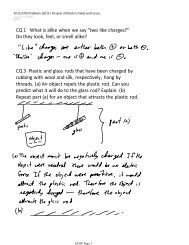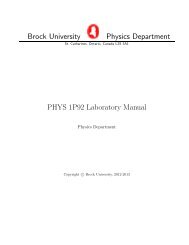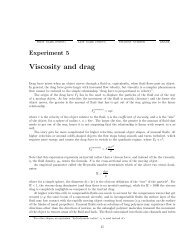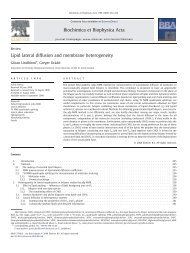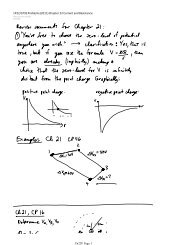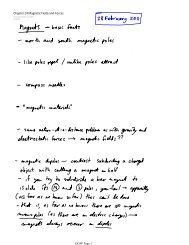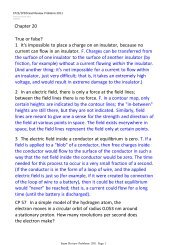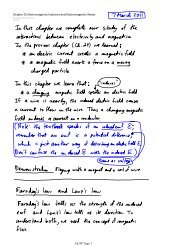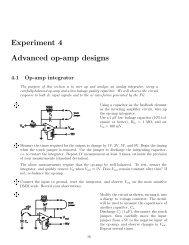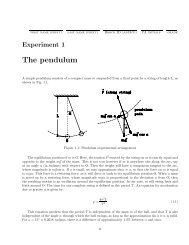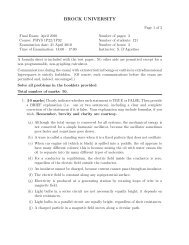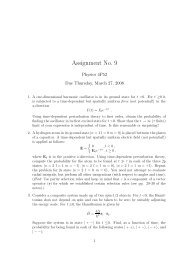Electric circuits, Current, and resistance - Physics Department ...
Electric circuits, Current, and resistance - Physics Department ...
Electric circuits, Current, and resistance - Physics Department ...
Create successful ePaper yourself
Turn your PDF publications into a flip-book with our unique Google optimized e-Paper software.
<strong>Electric</strong> <strong>circuits</strong>, <strong>Current</strong>, <strong>and</strong> <strong>resistance</strong><br />
(Chapter 22 <strong>and</strong> 23)<br />
Acknowledgements: Several Images <strong>and</strong> excerpts are taken from<br />
College <strong>Physics</strong>: A strategic approach, Pearson Education Inc<br />
Dr. Mangala Singh, 1P22/92 Brock University
Dr. Mangala Singh, 1P22/92 Brock University
<strong>Current</strong><br />
If electric charge (e.g.<br />
electron) moves, we will say<br />
an electric current, I, is set<br />
to exist.<br />
I<br />
+<br />
A<br />
An electric current, I, is the<br />
rate at which net charge (∆Q)<br />
flows through a surface area A<br />
I<br />
∆Q<br />
= ∆ t<br />
<strong>Current</strong>’s units = C/S <strong>and</strong><br />
often written as A (Ampere)<br />
Electrons are actual current carriers in<br />
metals. They flow opposite to the direction<br />
of electric field or current<br />
Although current carriers (i.e., charges)<br />
could be “+” or “-”, the direction of<br />
current will be in the direction of a “+”<br />
charge flow (i.e., clockwise)<br />
Dr. Mangala Singh, 1P22/92 Brock University
<strong>Current</strong> <strong>and</strong> <strong>Current</strong> density<br />
n = number of mobile<br />
charges per unit volume<br />
q = charge on each current<br />
carriers<br />
∆x = distance they move in<br />
a time interval ∆t<br />
v d = speed (called drift<br />
velocity )<br />
J = current density<br />
Drift velocity v d ?<br />
I<br />
∆ x = v ∆t<br />
d<br />
+<br />
∆ Q = ( nA∆x)<br />
q<br />
= ( nAv ∆t)<br />
q<br />
I<br />
J<br />
d<br />
∆Q<br />
= = nqvd<br />
A<br />
∆t<br />
I<br />
= = nqvd<br />
A<br />
A<br />
Dr. Mangala Singh, 1P22/92 Brock University
Multiple choice questions<br />
1. The charge carriers in metals are<br />
A. electrons.<br />
B. positrons.<br />
C. protons.<br />
D. a mix of protons <strong>and</strong> electrons.<br />
2. A battery is connected to a resistor. Increasing the <strong>resistance</strong> of the resistor<br />
will<br />
A. increase the current in the circuit.<br />
B. decrease the current in the circuit.<br />
C. not affect the current in the circuit.<br />
3. A battery is connected to a resistor. As charge flows, the chemical<br />
energy of the battery is dissipated as<br />
A. current.<br />
B. voltage.<br />
C. charge.<br />
D. thermal energy.<br />
Dr. Mangala Singh, 1P22/92 Brock University
Problem: The discharge of the electric eel can transfer a charge of 2.0 mC in a<br />
time of 2.0 ms. What current, in A, does this correspond to?<br />
Solution:<br />
Step 1: To solve a problem, note each <strong>and</strong> every quantities mentioned in<br />
your problem. In this problem<br />
Q = 2.0 x10 -3 C<br />
Time = 2.0 x10 -3 s<br />
<strong>Current</strong> = ?<br />
Step 2: Identify relationship between these quantities<br />
Step 3: Rearrange your equation to find out the unknown quantity<br />
Add each <strong>and</strong> every numbers <strong>and</strong> compute.<br />
Warning: Calculator does what you ask for….If you insert wrong numbers or in<br />
a wrong manner, you will get a wrong answer!!! You must learn how to use your<br />
calculator properly<br />
I = Q/t = 2.0x10 -3 C/2.0x10 -3 s = 1A<br />
Dr. Mangala Singh, 1P22/92 Brock University
Batteries<br />
The potential difference between the<br />
terminals of a battery, often called<br />
the terminal voltage is often called<br />
battery’s electromotive force (emf)<br />
Wchem<br />
∆ Vbat<br />
= =<br />
q<br />
ξ<br />
Dr. Mangala Singh, 1P22/92 Brock University
Simple Circuits<br />
The current is determined by the<br />
potential difference <strong>and</strong> the <strong>resistance</strong> of<br />
the wire:<br />
I<br />
=<br />
∆<br />
V wire<br />
R<br />
battery<br />
Dr. Mangala Singh, 1P22/92 Brock University
Ohm’s law <strong>and</strong> <strong>resistance</strong><br />
A current density J & the electric field E are<br />
established in a conductor when a potential<br />
difference (V b -V a ) is maintained across the<br />
conductor<br />
J = σE ------- Ohm’s Law<br />
σ is called electrical conductivity of the materials<br />
Ohmic materials: In these materials the ratio of J<br />
<strong>and</strong> E is a constant “σ”. In other words, it is J<br />
varies linearly with E<br />
Value of conductivity of the materials are different for<br />
different materials<br />
V = V −V<br />
b<br />
V<br />
E = ⇒ V = El<br />
l<br />
V<br />
J = σ E = σ<br />
l<br />
l<br />
V = I ⇒ V = RI<br />
σ A<br />
l<br />
R =<br />
σ A<br />
a<br />
ρL<br />
R =<br />
A<br />
Dr. Mangala Singh, 1P22/92 Brock University
Resistance & Resistivity<br />
The <strong>resistance</strong> of a wire depends on its dimensions<br />
(length L & Cross sectional area A) <strong>and</strong> the resistivity of<br />
its material.<br />
R =<br />
ρL<br />
A<br />
Every material has a characteristic resistivity that only<br />
depends on the properties <strong>and</strong> composition of the<br />
material.<br />
Value of resistivity of the materials are different for<br />
different materials<br />
resistivity of the metal increase as temperature increase<br />
resistivity of semiconductors <strong>and</strong> insulators decreases<br />
as temperature increases<br />
Dr. Mangala Singh, 1P22/92 Brock University
Multiple choice<br />
A battery is connected to a wire, <strong>and</strong> makes a current in the wire. Which of the following changes<br />
would increase the current?<br />
(1) Increasing the length of the wire; (2) keeping the wire the same length, but making it thicker; (3)<br />
using a battery with a higher-rated voltage; (4) making the wire into a coil, but keeping its dimensions<br />
the same; (5) increasing the temperature of the wire.<br />
Problem 1:<br />
A. All of the above<br />
B. 1 <strong>and</strong> 5<br />
C. 1, 4, <strong>and</strong> 5<br />
D. 2 <strong>and</strong> 3<br />
E. None of the above<br />
A wire has <strong>resistance</strong> of 21 ohm. It is melted down <strong>and</strong> from the same volume of metal a new wire is<br />
made, that is three times longer than the original one. What is the <strong>resistance</strong> of new wire<br />
Problem 2:<br />
The filament of a 100-W bulb carries a current of 0.83 A at the normal operating voltage of 120 V.<br />
A. What is the <strong>resistance</strong> of the filament?<br />
B. If the filament is made of tungsten wire of diameter 0.035 mm, how long is the filament?<br />
Dr. Mangala Singh, 1P22/92 Brock University
Power in Circuits<br />
Dr. Mangala Singh, 1P22/92 Brock University
Energy <strong>and</strong> Power in Resistors<br />
Dr. Mangala Singh, 1P22/92 Brock University
Multiple choice<br />
A resistor is connected to a 3.0 V battery; the power dissipated in the resistor is 1.0 W. The battery is<br />
traded for a 6.0 V battery. The power dissipated by the resistor is now<br />
A. 1.0 W<br />
B. 2.0 W<br />
C. 3.0 W<br />
D. 4.0 W<br />
Problem 1: An electric blanket has a wire that runs through the interior. A current causes energy to be<br />
dissipated in the wire, warming the blanket. A new, low-voltage electric blanket is rated to be used at 18<br />
V. It dissipates a power of 82 W. What is the <strong>resistance</strong> of the wire that runs through the blanket?<br />
Dr. Mangala Singh, 1P22/92 Brock University
Example Problem<br />
An electric blanket has a wire that runs through the interior. A current causes energy to be dissipated in<br />
the wire, warming the blanket. A new, low-voltage electric blanket is rated to be used at 18 V. It<br />
dissipates a power of 82 W. What is the <strong>resistance</strong> of the wire that runs through the blanket?<br />
Summary<br />
Dr. Mangala Singh, 1P22/92 Brock University
Conservation of <strong>Current</strong><br />
∑<br />
I<br />
in<br />
= ∑<br />
I<br />
out<br />
Dr. Mangala Singh, 1P22/92 Brock University
Multiple choice questions<br />
1. Rank the bulbs in the following circuit according to their brightness, from brightest to dimmest.<br />
A. A > B = C > D<br />
B. A = B = C = D<br />
C. A = D > B = C<br />
D. B = C > A > D<br />
Dr. Mangala Singh, 1P22/92 Brock University
Drawing Circuit Diagrams<br />
Dr. Mangala Singh, 1P22/92 Brock University
Kirchhoff’s Law<br />
∑<br />
I<br />
in<br />
= ∑<br />
I<br />
out<br />
∆ V = ∑ V =<br />
loop<br />
i<br />
0<br />
Dr. Mangala Singh, 1P22/92 Brock University
Using Kirchhoff’s Laws<br />
Dr. Mangala Singh, 1P22/92 Brock University
Multiple choice questions<br />
1. The diagram below shows a segment of a circuit. What is the<br />
current in the 200Ω resistor?<br />
A. 0.5 A<br />
B. 1.0 A<br />
C. 1.5 A<br />
D. 2.0 A<br />
E. There is not enough information to decide.<br />
2. The diagram below shows a circuit with two batteries <strong>and</strong> three resistors. What is the potential<br />
difference across the 200Ω resistor?<br />
A. 2.0 V<br />
B. 3.0 V<br />
C. 4.5 V<br />
D. 7.5 V<br />
E. There is not enough information to decide.<br />
Dr. Mangala Singh, 1P22/92 Brock University
Series Resistors<br />
Dr. Mangala Singh, 1P22/92 Brock University
Parallel Resistors<br />
Dr. Mangala Singh, 1P22/92 Brock University
Problems<br />
1. There is a current of 1.0 A in the circuit below. What is the<br />
<strong>resistance</strong> of the unknown circuit element?<br />
2. What is the current out of the battery?<br />
Dr. Mangala Singh, 1P22/92 Brock University
Analyzing Complex Circuits<br />
Dr. Mangala Singh, 1P22/92 Brock University
Problems<br />
1. In the circuit shown below:<br />
A. Rank in order, from most to least bright, the brightness of<br />
bulbs A–D. Explain.<br />
B. Describe what, if anything, happens to the brightness of bulbs<br />
A, B, <strong>and</strong> D if bulb C is removed from its socket. Explain.<br />
Dr. Mangala Singh, 1P22/92 Brock University
Problems<br />
In the circuit shown below:<br />
A. How much power is dissipated by the 12 Ω resistor?<br />
B. What is the value of the potential at points a, b, c, <strong>and</strong> d?<br />
Dr. Mangala Singh, 1P22/92 Brock University
Battery <strong>and</strong> its internal <strong>resistance</strong> (r)<br />
As the charges passes through<br />
from – to + terminal of the<br />
battery its potential energy<br />
increases<br />
The current in the circuit<br />
-Depends both external<br />
<strong>resistance</strong> to the battery<br />
-And its internal <strong>resistance</strong><br />
I<br />
=<br />
ξ<br />
R + r<br />
Due to internal <strong>resistance</strong> of the<br />
battery, its potential decreases<br />
by Ir, wherein I is the current.<br />
Terminal voltage of the battery<br />
= V +<br />
-V -<br />
= ξ-Ir<br />
Note: Terminal voltage may exceed the emf<br />
by an amount Ir – when the current is<br />
opposite the emf as in the case of charging a<br />
battery with another source of emf.<br />
Power dissipated, P, in the load<br />
<strong>resistance</strong> R<br />
ξ<br />
( R + r)<br />
2<br />
P 2<br />
= I R = R 2<br />
Dr. Mangala Singh, 1P22/92 Brock University
Problems:<br />
1. Show that maximum power lost in the load resistor R occurs<br />
when R =r, i.e., when the value of load <strong>resistance</strong> matches the<br />
internal <strong>resistance</strong> of the battery.<br />
Dr. Mangala Singh, 1P22/92 Brock University



